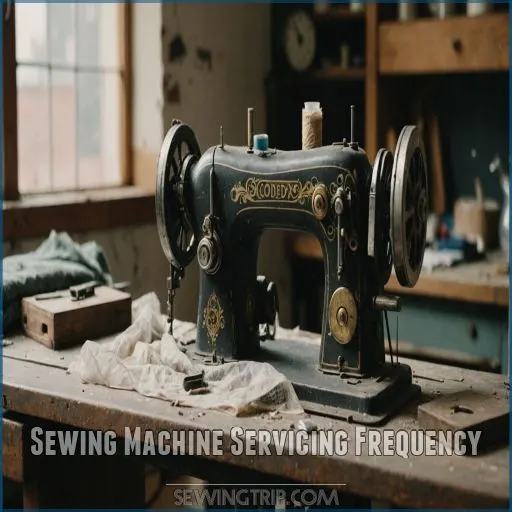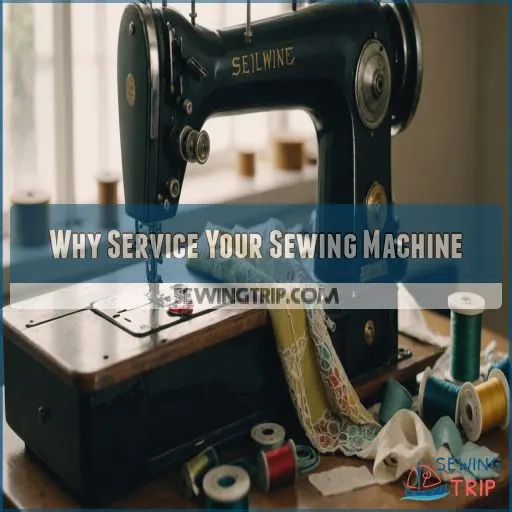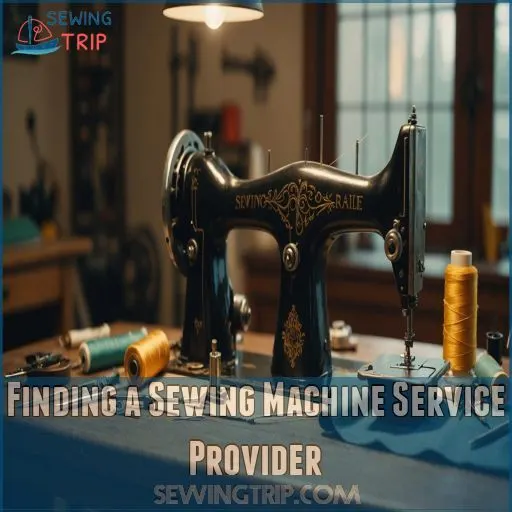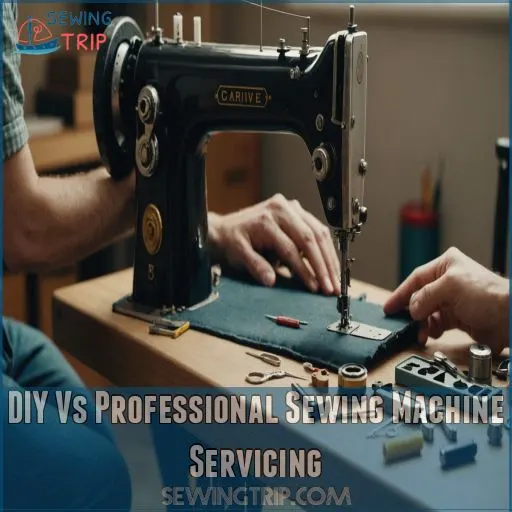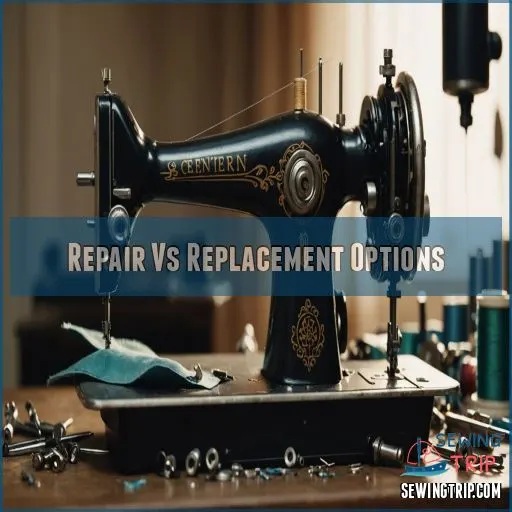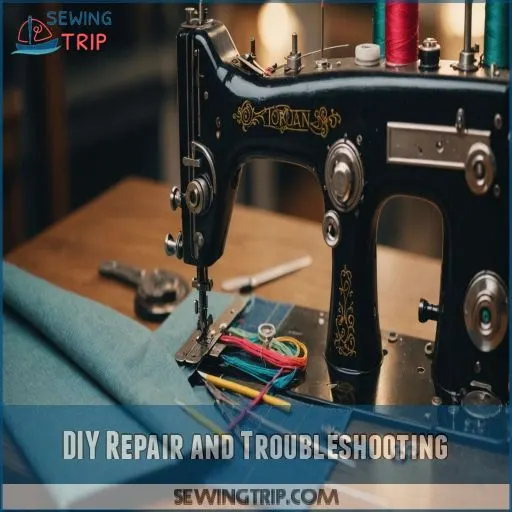This site is supported by our readers. We may earn a commission, at no cost to you, if you purchase through links.

Annual check-ups are ideal, but heavy users might need more frequent TLC. Regular servicing keeps your machine purring like a kitten, preventing those frustrating breakdowns mid-project.
It’s not just about avoiding repairs; it’s about maintaining peak performance and extending your machine’s lifespan. You’ll enjoy smoother stitches, fewer thread tangles, and the confidence to tackle any project.
While some basic maintenance is DIY-friendly, don’t shy away from professional servicing. It’s an investment that pays off in the long run.
Curious about what exactly goes into a proper service?
Table Of Contents
- Key Takeaways
- Sewing Machine Servicing Frequency
- Why Service Your Sewing Machine
- Finding a Sewing Machine Service Provider
- DIY Vs Professional Sewing Machine Servicing
- Repair Vs Replacement Options
- DIY Repair and Troubleshooting
- Sewing Machine Maintenance and Upkeep
- Is Servicing Worth the Investment
- Frequently Asked Questions (FAQs)
- Conclusion
Key Takeaways
- You should service your sewing machine annually, or every six months if you’re a heavy user. It’s like giving your trusty sidekick a spa day – it’ll keep your machine purring like a kitten and save you from costly repairs down the road.
- Don’t shy away from professional servicing. While DIY maintenance is great for basic upkeep, a professional can spot and fix issues you might miss. Think of it as sending your machine to sewing college – it’ll come back smarter and smoother than ever.
- Regular servicing is an investment in your craft. It’s not just about keeping your machine running; it’s about ensuring your creative flow isn’t interrupted by skipped stitches or tension troubles. Your future projects (and sanity) will thank you.
- Cleaning and oiling your machine between services is like flossing between dentist visits. It keeps things running smoothly and prevents small issues from becoming big headaches. Plus, it’s a great excuse to get up close and personal with your sewing companion.
Sewing Machine Servicing Frequency
When’s the last time you gave your sewing machine some TLC, like checking the fix sewing machine timing?
?
Regular servicing, whether it’s annually or every few hundred hours of stitching, keeps your trusty machine purring smoothly.
This can save you from annoying mishaps down the line due to lack of regular servicing.
Recommended Servicing Intervals
Wondering how often to service your sewing machine?
Aim for once a year – it’s like a spa day for your trusty stitcher!
A professional sewing machine service tackles knotty issues like oiling and tension adjustments, sparing you potential headaches.
Trust me, skipping these sessions is a fool’s errand.
Keep your machine humming happily, without breaking the bank, and make it a regular trustworthy maintenance routine. (Source)
Factors Affecting Servicing Frequency
Your sewing machine’s servicing needs depend on how often you use it, the types of fabrics you sew, and its age.
If you’re a frequent sewist working with heavy-duty materials, you’ll likely need more frequent tune-ups than someone who sews occasionally on lightweight fabrics.
Listen closely to your machine – any unusual noises or performance issues are signs it’s time for a checkup .
Manufacturer Guidelines
To keep your sewing machine running smoothly, follow your manufacturer’s guidelines religiously.
They lay out servicing intervals in user manuals to make sure:
- Warranty details are secure
- Recommended parts perform well
- Service history remains impeccable
- Sewing machine troubleshooting is minimal
So, don’t skip those maintenance checks—they’ll keep you sewing happy! And remember, your sewing machine deserves all the TLC.
Importance of Regular Servicing
So, you’re juggling threads like a pro, but is your sewing machine ready for the limelight?
Regular servicing keeps it purring like a kitten, boosting performance and extending its life.
A well-oiled machine staves off breakdowns, saving you repair costs and hassle.
Embrace this sewing wisdom and watch your creativity soar without a hiccup!
Why Service Your Sewing Machine
You wouldn’t drive your car for years without a tune-up, so why treat your sewing machine any differently?
Regular servicing is key to keeping it running smoothly, avoiding unexpected breakdowns and costly repairs.
Benefits of Regular Servicing
Think of regular sewing machine service as a spa day for your trusty companion. With improved stitch quality and increased efficiency, you’ll enjoy smoother projects and fewer repairs.
This TLC leads to a longer lifespan, making your machine purr like a kitten. By investing in regular tune-ups, which typically cost between $75 and $100, you can prevent hefty replacement costs and make sure your machine runs smoothly see servicing costs.
Regular maintenance also helps avoid common sewing machine issues, such as thread and needle problems, and fabric feeding inconsistencies, which a skilled sewing machine mechanic can diagnose through diagnostic testing methods
. Embrace these sewing machine tricks, reducing frustration, and let creative freedom sew its magic.
Preventing Breakdowns and Repairs
Imagine your sewing machine sputtering to a halt mid-project—nightmare, right?
Regular servicing is your secret weapon against such fiascos. It nips common issues in the bud through sewing machine care and preventative maintenance, ensuring machine longevity.
Don’t wait for it to fall apart; mastering common threading and tension issues sewing machine problems fixing could save you from needing a costly sewing machine upgrade or repair
. (Source)
Maintaining Machine Performance
A well-maintained sewing machine is your best friend.
To keep your machine performing at its best, remember to:
- Lubricate regularly to prevent parts from wearing out.
- Check needle care and replace your needle after every 8-10 hours of use.
- Adjust thread tension to prevent thread breakage and make sure stitching is smooth.
Extending Machine Lifespan
You want your sewing machine to live a long, trouble-free life, right?
Proper lubrication and regular cleaning routines keep it purring like a kitten.
Needle care and smart parts replacement save headaches later, while thoughtful machine storage prevents wear.
It’s like a spa day for your machine—only it results in years of smoother sewing adventures!
Finding a Sewing Machine Service Provider
Finding a reliable sewing machine service provider doesn’t have to be a headache.
Check with your local repair shops, sewing machine retailers, or even reach out to your machine’s manufacturer.
They’ll point you in the right direction and make sure your trusty companion gets the TLC it deserves.
Local Repair Shops and Retailers
Just like keeping a car in good shape ensures smooth rides, finding a reputable local repair shop keeps your sewing machine humming.
Consider these tips:
- Check Reviews: Look online for service quality feedback.
- Compare Costs: Contact local shops for estimates.
- Seek Recommendations: Ask friends or fellow sewing enthusiasts.
When searching for a sewing machine repair shop, you can also utilize local listings, such as checking the local yellow pages or online directories, to find a nearby shop. Additionally, consider contacting the Better Business Bureau for reputable repair shops.
Imagine the peace of mind with expert hands pampering your machine.
Manufacturer Recommendations
Upon purchasing a sewing machine, relying on manufacturer recommendations can be a lifesaver.
Consult the warranty, adhere to service intervals, and use recommended kits. Service centers provide expert maintenance, making sure parts availability and longevity.
Why settle for guesswork? Keeping your machine in tip-top shape beats the hassle of unexpected breakdowns.
| Aspect | Importance | Tip |
|---|---|---|
| Warranty | Protects investment | Understand terms and conditions |
| Service Intervals | Maintains function | Follow manufacturer schedule |
| Parts Availability | Ensures longevity | Verify with service provider |
Sewing Machine Dealers and Clubs
Don’t let your sewing machine gather dust!
Connect with local dealer networks for great repair recommendations. Join club events for community resources and hands-on learning.
It’s like a membership benefits bonanza—never feel like you’re stitching solo again.
So, why not jump into the experience? Find nearby sewing machine dealers and keep your creativity flowing smoothly.
DIY Vs Professional Sewing Machine Servicing
You might think your sewing machine just needs a quick dust-off and oil, but skipping professional servicing can make it as finicky as a cat with a wet tail.
While DIY maintenance keeps things humming week to week, a pro’s touch makes sure those hidden gears and gizmos don’t turn your next quilting project into a tangled mess.
Basic Cleaning and Maintenance Tasks
You’ve found a great provider; now let’s talk DIY cleaning.
Keep your machine humming with regular tasks like needle replacement, resolving threading issues, bobbin care, dust removal, and oil lubrication, including using compressed air to blow out dust safely from areas like the tension disks and feed dogs.
It’s like giving your car a mini-tune-up. Consistent TLC prevents snags and keeps projects flowing smoothly.
Who knew maintaining sewing zen could be this easy and satisfying?
Limitations of DIY Servicing
While DIY sewing machine servicing can be tempting, it has its limitations.
Older machines may require specialized tools and expertise you may lack. Complex repairs like gear replacements or electronic issues are best left to the pros.
Attempting DIY servicing on a newer machine could even void the warranty. Knowing your limits is key to keeping your sewing machine in top shape.
- Limited DIY Expertise
- Lack of Specialized Tools
- Warranty Concerns for New Machines
Importance of Professional Servicing
Choosing between DIY and professional servicing is like deciding between a homemade sandwich and one crafted by a chef.
Professional servicing offers lasting service benefits, with expert advice ensuring machine longevity and preventative care.
Spotting issues before they bloom into costly repair costs is key to keeping your sewing dreams alive.
| Aspect | DIY | Professional |
|---|---|---|
| Expertise | Limited | Expert Advice |
| Machine Longevity | Variable | Prolonged |
| Repair Costs | May Increase | Often Reduced |
Cost Comparison and Value
Considering both cost and value over time, DIY servicing saves bucks but needs skill and patience—a bit like threading a needle on a moving train.
Professional servicing can seem pricey, but it extends machine lifespan and saves on costly replacements.
So, weigh the DIY repair costs against replacement headaches to find your needle in the haystack .
Repair Vs Replacement Options
When your sewing machine starts acting up, you face the age-old dilemma: fix or toss.
Before you start Googling new machines, let’s weigh the repair costs against replacement options—sometimes a little TLC can save you loads of cash and hassle.
Evaluating Repair Costs and Benefits
You’ve scrubbed and tinkered with your sewing machine, and now you’re at a crossroads: repair or replace.
Evaluate repair cost factors. If repair expenses are under 75% of the purchase price, it’s generally worth it. Beyond that, consider if a new model might stitch up your woes.
Remember, sometimes old works like an old friend: reliable, but flawed.
Considering Machine Age and Value
Thinking about your sewing machine’s longevity? The age and value of vintage machines often warrant a repair over replacement. A trusty old model could offer better quality than newer, budget-friendly options. Consider the charm of continuing its legacy!
- Vintage machine care: Essential for extending lifespan.
- Repair cost analysis: Weigh expenses wisely.
- Machine value assessment: Understand worth.
- Upgrade considerations: Think before replacing.
Weighing Repair and Replacement Costs
As you weigh your sewing machine’s fate, consider whether repair costs are worth it, especially for a vintage machine that’s got hidden charm.
Here’s a quick glance:
| Aspect | Consideration |
|---|---|
| Vintage Machine Value | Sentimental and monetary worth |
| Repair vs New Cost | Smaller fixes might be cheaper |
| DIY Repair Limits | Risk of trial and error |
Think of those quirks as character!
Factors Influencing Repair and Replacement Decisions
So, your trusty sewing machine is acting up – time to weigh the repair versus replacement options.
Consider the machine’s age, repair history, and the cost of fixes, including the potential cost of labor and any additional repairs.
You’ll also want to factor in the availability of parts and whether they’re compatible with your machine’s model.
Is it a quick fix, or the tip of the iceberg?
Consult a pro to get the lowdown and make the call that’s right for you and your machine, and consider researching sewing machine repair costs to make an informed decision.
Consult a pro to get the lowdown and make the call that’s right for you and your machine, and consider researching sewing machine repair costs to make an informed decision.
DIY Repair and Troubleshooting
Trying to fix your sewing machine on your own might feel like wrestling with a stubborn cat, but it can save you money and teach you new skills.
Knowing when to tackle common issues yourself and when to call in the pros is key to avoiding more headaches down the line.
Common Sewing Machine Problems
Why is your sewing machine acting like a diva? It might be one of these common problems:
- Needle Breakage: Check for bent needles before the next meltdown.
- Thread Jams: Re-thread your machine like a pro.
- Skipped Stitches: Adjust the tension to avoid gaps.
- Bobbin Issues: Make sure it’s wound correctly to prevent chaos.
DIY Repair Options and Limitations
Tackling DIY repair on your sewing machine feels like taming a wild beast—exciting and a bit scary. Common sewing machine problems often need simple DIY repair tools, yet repair complexity can quickly soar. Replacement parts might just drain your wallet more than you bargained. The key? Balancing cost vs. time becomes important.
| Problem | DIY Solution |
|---|---|
| Bobbin issues | Re-thread bobbin |
| Needle breaks | Change needle |
| Tension issues | Adjust tension |
| Strange noises | Check for jams |
| Skipped stitches | Clean machine |
When to Seek Professional Help
The decision to call in the cavalry, aka professional help, isn’t always cut and dry.
If you’re facing persistent issues, like skipped stitches or motor malfunctions, consider waving the white flag:
- Sewing machine repair costs can skyrocket without expert advice.
- Warranty coverage might depend on professional intervention.
- Older machines have quirks best handled by pros.
Sewing Machine Maintenance and Upkeep
Keeping your sewing machine in top shape isn’t just about cleaning lint.
It’s like giving it a spa day to keep it running smoothly and save yourself future headaches.
Regular maintenance, like oiling parts and replacing needles, makes sure your machine doesn’t throw a tantrum halfway through your next project.
Regular Maintenance Tasks and Schedules
You’ve mastered DIY repairs; now focus on keeping your sewing machine humming with regular maintenance.
Establish a cleaning routine, replace needles, and lubricate with the right oil types. Remember, a maintenance kit and proper storage tips go a long way.
| Task | Frequency | Tips |
|---|---|---|
| Cleaning routine | Monthly | Use a brush |
| Needle care | Every project | Swap often |
| Oil types | Bi-monthly | Follow manual |
Importance of Cleaning and Lubrication
Keeping your sewing machine in tip-top shape is a breeze. Regularly cleaning and lubricating the inner workings is key. Grab some sewing machine oil and a lint brush, and give those gears a little TLC.
Trust me, your machine will purr like a kitten (Source). Just don’t forget to wipe away any excess oil.
"What is a sewing machine service?"
Your sewing machine will work better if you oil and clean it regularly.
Wipe away any excess oil with a cloth, then screw the needle plate back into the machine.
Needle Replacement and Thread Care
A sharp needle and quality thread are your sewing machine’s best friends, especially when working with a clean needle plate cover.
.
Change needles every 6-8 hours to avoid stitch drama or fabric accidents.
Match needle types to fabric for smooth sailing.
Don’t forget thread care—store spools away from sunlight to maintain thread quality.
Remember, with good needle maintenance and appropriate thread tension, you’ll sew like a pro!
Storage and Handling Best Practices
Imagine your sewing machine lounging like a couch potato—covered, dust-free, and secure.
A machine cover keeps dust bunnies at bay, while a clean workspace makes sure it works properly.
Store needles separately to avoid chaos.
And when transporting safely, remember your machine’s as delicate as Aunt Edna’s porcelain vase. Handle with care, and it’ll work like a charm!
Is Servicing Worth the Investment
Ever found yourself struggling with a sewing machine that’s giving you all sorts of headaches?
Investing in regular servicing might feel like an extra chore, but it can boost your machine’s performance and longevity.
Saving you from buying a new one sooner than you’d expect!
Cost-Benefit Analysis of Servicing
Weighing the service costs against benefits can save you headaches down the road. Think of it like a health check for your machine—small fixes now prevent costly repairs later.
Professional maintenance outshines DIY for complex issues, especially as machines age. Plus, regular service prolongs lifespan, sparing you from buying a new one.
Consider:
- Upfront service costs
- DIY vs. pro choice
- Impact of machine age
- Future repair savings
- Prolonged lifespan benefits
Impact on Machine Performance and Lifespan
You’d be amazed at how regular servicing can breathe new life into your trusty sewing companion.
It’s like giving your machine a spa day! Proper maintenance keeps your needle in tip-top shape, ensuring crisp stitches every time.
A well-oiled machine purrs along smoothly, tackling tough fabrics with ease.
Don’t let a neglected machine cramp your style – a little TLC goes a long way in keeping your creativity flowing freely.
Comparison to Replacement Costs
Your sewing machine’s longevity hinges on regular tune-ups. Comparing repair costs to replacement isn’t just about dollars and cents; it’s about preserving a trusted companion.
Let’s stitch together the facts:
- Tune-ups typically range from $75 to $100
- Computerized embroidery machines may cost up to $250 for basic repairs
- DIY maintenance can stretch service intervals to every 2 years
- Professional servicing prevents significant issues and unexpected expenses
- Vintage machines may appreciate over time, making repairs worthwhile
Long-Term Value and Benefits
Think of servicing your sewing machine as giving it a spa day – it’s an investment in longevity and peak performance.
Regular maintenance has numerous benefits. Servicing your sewing machine boosts sewing efficiency and prevents costly breakdowns. You’ll save money in the long run through preventative care, potentially increasing your machine’s resale value.
By taking care of your machine, you’re also nurturing your creativity. It’s like feeding your creativity machine its favorite snack – keep it happy, and it’ll reward you with years of smooth stitching!
Frequently Asked Questions (FAQs)
How often should a sewing machine be serviced?
A stitch in time saves nine thousand headaches!
Aim to service your sewing machine annually. For heavy users, every six months keeps things humming.
Regular maintenance extends your machine’s life, ensuring smooth sewing and preventing costly repairs down the road, which is a costly repair.
Is it necessary to service a sewing machine?
Regular sewing machine servicing is really important.
It’s like giving your trusty sidekick a spa day, ensuring smooth operation and longevity.
Clean after every 2-3 bobbins, and book an annual professional tune-up to keep your stitches perfect and your machine purring.
Can a sewing machine be repaired?
Most sewing machines can be repaired.
From belt replacements to motor fixes, skilled technicians can breathe new life into your trusty stitcher.
Don’t toss it yet – a little TLC might have it humming along in no time.
Why do you need a sewing machine repair service?
Your sewing machine’s purring like a kitten, right? Wrong!
Without regular tune-ups, it’ll stitch you up.
You’ll face skipped stitches, tension troubles, and mysterious noises.
Don’t let your trusty sidekick become a temperamental diva.
Keep it humming with professional TLC.
Does a sewing machine need to be serviced?
Sewing machines need annual check-ups, just like your car.
They’ve got moving parts that dry out and wear down. Regular servicing keeps your trusty stitching sidekick humming along smoothly, preventing bigger issues down the road.
Don’t let it become a dusty paperweight! Regular maintenance is key to keeping your machine in good condition, and it’s especially important for preventing bigger issues.
Is it worth servicing a sewing machine?
Regular servicing is a stitch in time that saves nine.
You’ll extend your machine’s lifespan, prevent pesky issues, and keep it humming like new.
Think of it as a spa day for your trusty sewing companion.
How often should you maintenance your sewing machine?
Like a well-oiled machine, treat your sewing companion to monthly at-home TLC.
Clean out lint, oil moving parts, and listen for unusual sounds.
Schedule professional tune-ups yearly to keep it humming.
You’ll stitch up success in no time, having properly maintained your machine.
How do I service my sewing machine?
Revive your trusty stitching companion!
Unplug, remove covers, and grab your toolkit. Clean lint with a brush, oil moving parts sparingly, and check tensions.
It’s like giving your machine a spa day – she’ll purr with gratitude!
How long does a sewing machine service take?
You’ll typically have your sewing machine back in 1-2 weeks.
The actual service takes a few hours, but shops often have a queue.
For a quicker turnaround, ask if they do on-site repairs.
Can vintage sewing machines be professionally serviced?
Professional restoration services breathe new life into vintage sewing machines.
Experts can clean, lubricate, and adjust your treasured machine, often for as little as $85 .
They’ll even replace wiring and hunt down rare parts if needed.
What supplies are needed for DIY cleaning?
Grab your toolkit, fellow stitcher!
You’ll need small screwdrivers, a lint-free cloth, and sewing machine oil. Don’t forget a towel that can handle some grime.
With these supplies, you’ll be ready to give your trusty machine a spa day!
Does servicing include replacing worn-out parts?
In a whirlwind of maintenance, servicing often includes replacing worn-out parts.
Technicians inspect your machine’s innards, swapping out tired components like belts, cords, and tension assemblies.
You’ll get a tune-up that breathes new life into your faithful stitching companion.
How to clean the bobbin case area?
First, unplug your machine.
Remove the needle plate. Take out the bobbin case and brush away lint. Use tweezers for stubborn threads.
Don’t forget to oil the center post. It’s like giving your machine a spa day!
Conclusion
Your sewing machine, like a faithful companion, deserves your care.
Just as you wouldn’t neglect a trusted friend, you shouldn’t overlook servicing your machine. Regular check-ups keep it humming along, ready for your next creative burst.
Remember, should you service your sewing machine? Absolutely. It’s not just maintenance; it’s an investment in your craft.
By giving your machine the attention it needs, you’re ensuring countless hours of smooth stitching and fabric-filled fun.
So, treat your trusty sidekick right – your future projects will thank you.

